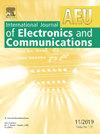A dual-band frequency-selective surface with rectangular filtering characteristic for the second band enabled by harmonics resonance
IF 3.2
3区 计算机科学
Q2 ENGINEERING, ELECTRICAL & ELECTRONIC
Aeu-International Journal of Electronics and Communications
Pub Date : 2025-09-09
DOI:10.1016/j.aeue.2025.155961
引用次数: 0
Abstract
In this article, a dual-band frequency-selective surface is proposed, which the second band is realized utilizing higher harmonics. First, source of harmonics from a traditional single-layer X-shaped slot FSS is analyzed. Second, based on the equivalent circuit model (ECM) method, a dual-band FSS is proposed by loading a cross-dipole patch as band-stop filtering circuit, which the second band is designed close to the higher harmonics. Then, to utilize the higher harmonics, an ECM with odd- and even-mode analysis is proposed to guide the synthesis of the FSS. Cascading the top and bottom layers of the modified X-shaped slot layers and the middle cross-dipole patch layer, harmonic coupling is achieved, resulting in good rectangular filtering characteristic of the second passband is obtained. The simulated results indicate that the 3 dB relative bandwidth of the two passbands are 24.2% and 14.4%, and the roll-off rates at the left and right edges of the second passband are 233 dB/GHz and 47 dB/GHz, respectively. Finally, the prototype is fabricated and measured, showing good agreement with simulation results and angular stability up to 45°under TE polarization.
一种双波段频率选择表面,其第二波段具有通过谐波共振实现的矩形滤波特性
本文提出了一种双频选择曲面,其中第二波段利用高次谐波实现。首先,分析了传统单层x形槽FSS的谐波源。其次,基于等效电路模型(ECM)方法,通过加载交叉偶极子贴片作为带阻滤波电路,提出了一种双带FSS,其第二带设计接近高次谐波。然后,为了利用高次谐波,提出了一种奇偶模分析的ECM来指导FSS的合成。将改进的x形槽层的上下两层与中间的交叉偶极子贴片层进行级联,实现了谐波耦合,从而获得了良好的第二通带矩形滤波特性。仿真结果表明,两通带的3db相对带宽分别为24.2%和14.4%,第二通带左右边缘的滚降率分别为233 dB/GHz和47 dB/GHz。最后对样机进行了制作和测量,结果与仿真结果吻合较好,在TE极化下角稳定度可达45°。
本文章由计算机程序翻译,如有差异,请以英文原文为准。
求助全文
约1分钟内获得全文
求助全文
来源期刊
CiteScore
6.90
自引率
18.80%
发文量
292
审稿时长
4.9 months
期刊介绍:
AEÜ is an international scientific journal which publishes both original works and invited tutorials. The journal''s scope covers all aspects of theory and design of circuits, systems and devices for electronics, signal processing, and communication, including:
signal and system theory, digital signal processing
network theory and circuit design
information theory, communication theory and techniques, modulation, source and channel coding
switching theory and techniques, communication protocols
optical communications
microwave theory and techniques, radar, sonar
antennas, wave propagation
AEÜ publishes full papers and letters with very short turn around time but a high standard review process. Review cycles are typically finished within twelve weeks by application of modern electronic communication facilities.

 求助内容:
求助内容: 应助结果提醒方式:
应助结果提醒方式:


